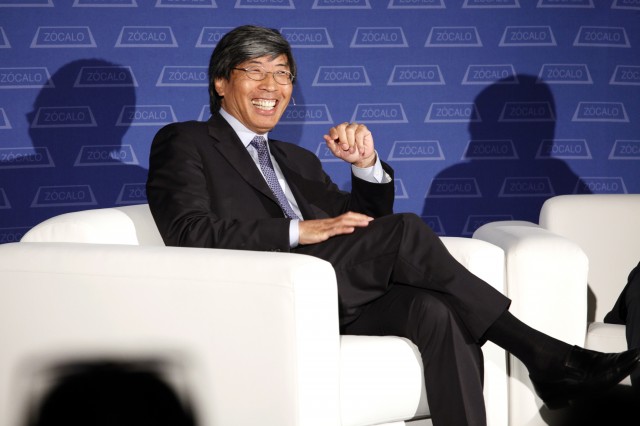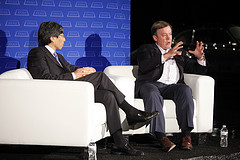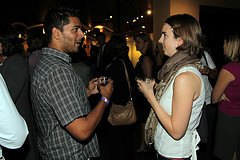
We’ve all heard the dismal facts about the American healthcare system: high spending, low-quality treatment, poor delivery, and spotty access. But biomedical innovator, businessman, and physician Patrick Soon-Shiong–who is also the richest man in Los Angeles and a Lakers part-owner–says the problems aren’t intractable. Far from it. Instead, we’re on the cusp of a more personalized, more accurate, and less error-prone era in American medicine. In fact, Soon-Shiong indicated that in less than a month, when he is in Washington, he will announce the development of a new system of wireless healthcare integration and molecular medicine that could change how we treat illness and how we prevent it.
Soon-Shiong was introduced to the crowd at the Petersen Automotive Museum by Arizona State University President Michael Crow, who is also a scientist with a background in innovation and technology transfer. “Meet Batman,” Crow told the audience. Like Bruce Wayne, Soon-Shiong is a polymath and businessman using “mysterious technologies” to wage a war–not on crime but on disease and avoidable early death. Soon-Shiong aims to extend, in a cost-effective manner, our “healthspan”–that is, the healthy and productive years of a person’s life.
What, Crow asked Soon-Shiong, is driving you to take on a monumental problem that even the government can’t seem to tackle?

I’m driven “from the position of physician,” said Soon-Shiong, who is also a surgeon and was a professor at UCLA’s medical school. Over and over again, he has seen patients receive the wrong treatment–and suffer as a result–not because the right treatment didn’t exist but because doctors don’t have the needed cognitive support or enough information to make the right decisions. “I’m driven by opportunity lost not just for the patient or for our country but mankind,” said Soon-Shiong.
There are three barriers, said Soon-Shiong, to getting doctors the information they need: knowledge, delivery, and payment.
The knowledge barrier “is exploding every day,” he said. In the past five years we’ve made more scientific discoveries and breakthroughs, and developed more tools for improving our health, than in the last 50 years in medicine. But this knowledge takes an average of 17 years to get to patients.
The barrier to better healthcare delivery is in transferring information and coordinating care from the clinic to the lab and the hospital to the home; patients aren’t getting the decision support they need and could receive.
Our payment system is the final barrier. Doctors and hospitals are reimbursed not to keep you healthy but to do as much as they can when you’re sick. These “perverse incentives,” said Soon-Shiong, get in the way of patients receiving preventive care.
These problems are massive, but Soon-Shiong decided that they could be integrated into a single solution by attacking them in their most severe manifestation: when a patient is diagnosed with cancer. “If we can address illness and fix the system in a state of emergency, then we can fix it in [a state of] wellness,” he said.
Two million people are diagnosed with cancer each year, but the “scariest statistic,” said Soon-Shiong, is that 32 percent of the patients receive the wrong treatment.
Crow explained that most cancer drugs work for a small number of patients but are administered to a much larger number of patients in the hope that they’ll somehow work.

It doesn’t have to be this way, said Soon-Shiong. We have the ability, with our knowledge of the cancer genome, to find out what caused a person’s cancer at the molecular level and to treat that specifically rather than administering a blanket treatment that has a low statistical probability of success. The cost of this sort of treatment is also decreasing. This year, it will cost $1,000 (less than a CAT scan) for a complete genomic analysis of a blood test, which can identify with great precision what’s going on when you’re ill.
This molecular medicine, coupled with wireless technology, could change how cancer and other diseases are treated and how preventive medicine is administered. Computer and cloud technology has made it possible to monitor our vital signs in real time and to share this information with our doctors wirelessly–as well as to have it analyzed, and to have that analysis sent to patients on their smartphones.
“It sounds crazy, but that’s what we do, and what we’ve done,” said Soon-Shiong. His October announcement will reveal how he’s successfully implemented this technology and how it could improve care across the board, level the healthcare playing field, and be exported from the U.S. into other countries. It’s taken seven or eight years, investment in a host of institutions, and the integration of the work of doctors and computer scientists, nurses and healthcare providers. But Soon-Shiong thinks it may revolutionize U.S. healthcare and the treatment of a host of chronic diseases, from heart disease and diabetes to Alzheimer’s. Soon-Shiong has already introduced the program to 8,000 oncologists, whose rate of treatment error he says has gone from 32 percent to zero in treating cancer patients.
Crow asked Soon-Shiong to address some of the privacy concerns patients might have about their health information being transmitted wirelessly. “You need to recognize that this is your data,” said Soon-Shiong–it’s something that a patient shares with a doctor, not the other way around.
So what, asked Crow, is stopping you from implementing this right away?
Soon-Shiong explained that waste is embedded in our healthcare system: “Some people’s waste, other people’s profit,” he said. “There’s not one penny being spent [by the government] on what I just talked to you about.” The pharmaceutical industry doesn’t see the upside in developing a drug that can treat 100 people. The insurance companies don’t exist to keep patients healthy but as brokerage systems. And in academia, silos are keeping research and clinical practice separate.

In the question-and-answer session, audience members asked Soon-Shiong if the FDA is posing another hurdle, what the medical school and hospital of the future will look like, and if there’s a point in getting genetic information that doctors can’t act on.
Regarding government drug regulation, Soon-Shiong said that he has “a fabulous personal relationship with the FDA.” He had 70 drugs approved in 10 years when he began developing drugs. The FDA’s Critical Path Initiative is also working to speed up the process of developing drugs and adjusting to the speed of the new world of molecular medicine. “I’m hopeful,” he said, about the future of the drug test and trial process.
“If I have a complete genome analysis and find out that in the future I will have breast cancer, what do I do with that information?” asked an audience member.
Soon-Shiong said he shared this skepticism a decade ago when the genome was discovered, thinking that predictions and probabilities would cause more stress than they were worth. But today, genomic medicine has evolved to the point where an abnormality or illness can be identified and treated as it’s occurring. “If you’re going to do a test for something for which I can do nothing, don’t do the test,” he said. “But if you can do a test that can change the direction of a treatment, you should do the test.” The concept of the genome is really for treatment of illness, he concluded.
Another audience member asked Soon-Shiong what he thinks medical schools and hospitals will look like in the future. Soon-Shiong predicted more integration in medical schools among not just physicians and nurses but other fields like economists. He thinks we’ll also see a reversion back to a form of medicine that’s more like the home care he received growing up in South Africa–the doctor coming to the door with a black bag. The doctor will become more like a priest, with a great deal of personalized information about patients–but patients, too, will have access to the same deep level of information.
Watch full video here.
See more photos here.
Read medical professionals’ opinions on how our routine physicals will change in the next decade here.
Read about the challenges facing L.A.’s biomedical industry and its potential here.
*Photos by Aaron Salcido.




Send A Letter To the Editors